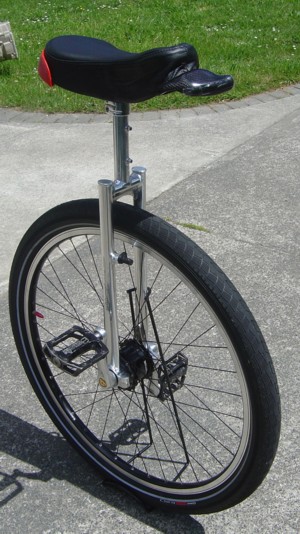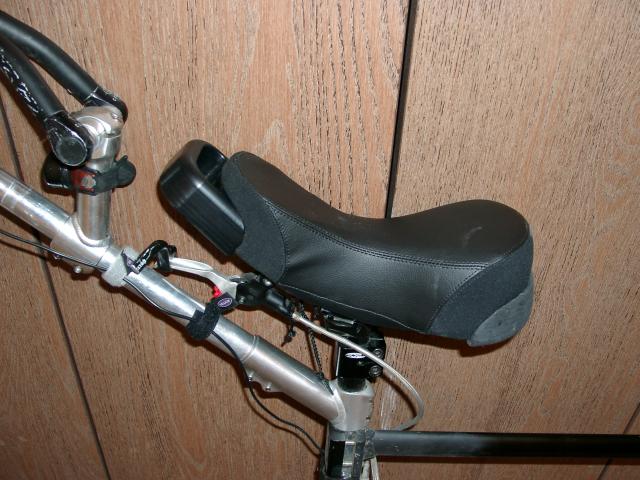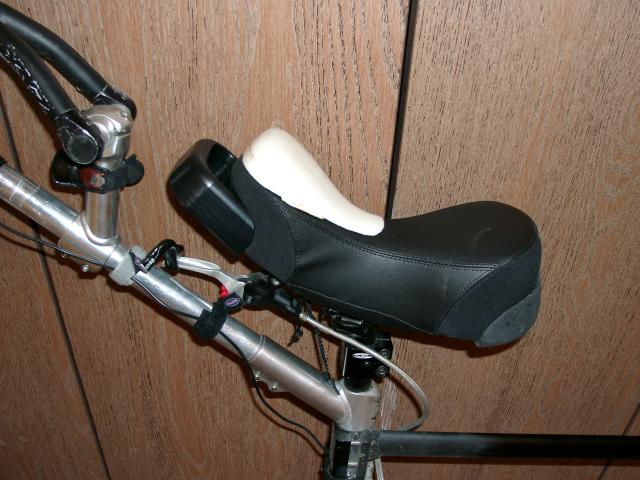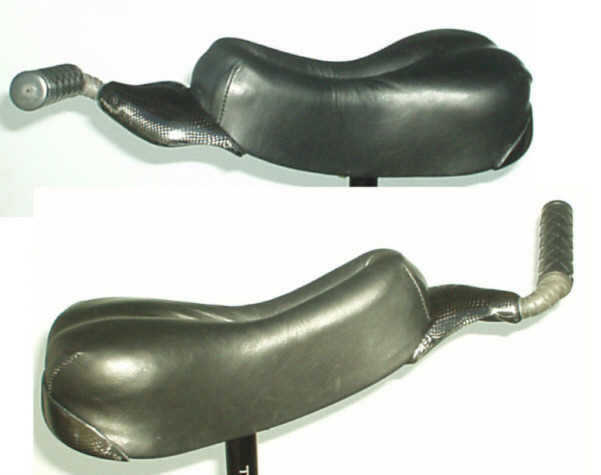I finally got my Schlumpf 29’er set up today. I’ve been so busy that it’s only had a cursory ride up and down the road as it was waiting for me to set up a proper seat. I gave up on the bike seat idea because I couldn’t find a stem long enough to not bang my legs on.
So after an afternoon of chopping up my new Scott Wallis/Carbon seat (thanks Scott!) I finally have it rideable. I went with the theory that long distance seats should be flat as possible so that you aren’t squishing your squishy bits for hours on end. It’s still not perfect, but I carved up the foam so that the saddle has only a minimal curvature. I switched over to my Miyata carbon base due to the lesser concavity of it.
The set-up is as follows:
Schlumpf 29’er- hub, 125mm cranks, frame as standard
Big Apple tyre
Snafu pedals
Miyata carbon seatbase
Scott Wallis Deathgrip handle
Scotts wire/leather seatcover
Scotts double density foam, chopped to bits to make it flat
So yes, it was all set to go- only problem was that I was down with a bad flu-thought my head was going to implode (someone was tightening a vice around it:( ).
But then I thought, I’d feel much worse if I had to wait until I was feeling better before riding it, so off I went.
The ride: 17km to Makara Beach from my house- lot’s of rolling hills, but slightly more down than up.
It took a few practice attempts earlier in the week before I could actually freemount the thing. It rides like a 43.5" wheel- so there is a lot of momentum built in. However, it is also much lighter than a Coker- so even though it was geared up more, it felt very similar in responsiveness to the Coker.
Off I went up the first hill- this thing rockets along like my Diet Coker on speed. My legs weren’t feeling great, so I waddled my way up that hill and ended up flicking it over th 1:1 mode. After riding in 1:1.5 mode I was unable to ride freemount it in 1:1- it took three attempts and three UPDs before I could get going again.
Back down the hill and I flicked it to 1:1.5 and this thing just rocketed away. It is slightly twitcher than a Coker, so more attention is needed to keep this thing from killing you. I had one high speed UPD, with resulting in the sound of my shiny new Carbon Deathgrip handle rubbing it’s way across the tarmac at 25km/h. Scratched but still intact, I was a bit more cautious for the rest of the ride, along with the fact that I was about to throw up all over the road.
I made it to Makara Beach in 40:07. My best Coker (110mm cranks) Time is 40:20. The Coker time was set when I was fit and not dying of the flu, so I think on a better day the Schlumpf should be at least 5min faster. The return trip took 1:29:18. My best Coker time (and it took some effort to do) is 1:30:20.
I rode with a Road Cyclist on the way back, and for the first time I felt like I could keep up a reasonable pace without spinning my legs off. The Schlumpf feels more like you’re riding a bike than a unicycle- it goes that fast. One other thing- the flattened seat is way more comfy than my previous curved seats. It required your hands firmly on the handle to stop you slipping forwards, but distance riders tend to keep their hands on the handle all the time anyway.
The only trouble I had with the Schlumpf was the wheelbuild- the spokes aren’t tensioned that well and were clicking all the time. Looks like my first upgrade will be a decent wheelbuild.
Next challenge will be the Basin Reserve (where I set the 24hr record). Will see how fast it goes under more measured conditions when I’m feeling better.
Ken



